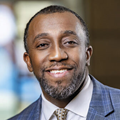What Now?

By Andre Harris, MD, chief medical officer, Atrium Medical Center
May 25, 2020 was a dark day, but also an enlightening one: It was the day that George Floyd died at the hands of Minneapolis Police. The travesty of a Black man dying at the hands of the police wasn’t new, but the nation’s response definitely was. The Black community gained allies from corporations, the NBA, local governments, and individuals. Protests in the streets had a demographic unlike any in our history: young white men and women. Premier Health stepped forward and organized sessions to educate our leaders on racism, white privilege, microaggressions, and being allies. Corporations have pledged millions of dollars to fight racial injustice. Yet, like every movement in history, there is a beginning, middle, and end. We seem to be somewhere in the middle and, if so, the question is: What now?
Much needs to happen in America when it comes to racial equality, but I would like to focus on what we do best at Premier Health - health care. Our next step is how do we level the playing field when it comes to racial disparities in medicine?
What I consider a foundational step is the recruitment and retention of Black physicians to the Miami Valley. We are blessed with a medical school in our backyard that positions us well to show young Black doctors why Dayton is where they would want to practice. My rationale for singling out the Black physician is that historically they have been the physicians who will open and sustain practices in underserved communities of color. The recruitment can be based in scholarships that pay for medical school (with the caveat that the physician will maintain a practice in an underserved area for a certain number of years). The National Health Service Corps has used this model for years to push primary care physicians into underserved communities across America (I am a proud alumnus of the program).
Another way to address racial disparities in medicine is through partnering with Horizons in Medicine, a program started in 1979 at Wright State University. The program focuses on taking high school students from minority communities through a curriculum that exposes them to medicine. The program director has used my office and those of other Black physicians throughout the community as sites for the students to visit during the program. At the end of the program, students compete for a renewable scholarship to Wright State.
The last way to examine these disparities that I’d like to highlight is a very personal one for each and every person reading this column. The concept is that of reflection. Having heard the protests and the pundits, you have to reflect personally on biases. Statistics have shown throughout history that Black and Brown people do not fare as well when it comes to top-notch medical care. But when you reflect on the process you can see why. In Dayton, most of those living in a lower social economic status present to Miami Valley Hospital with a CareSource card. The vast majority of their care is provided by residents (physicians in training). This is not to say that our residency programs provide sub-par care. On the contrary, I am proud of the education that I received as a resident at MVH and would welcome any future resident to get their training here. Where I feel the focus should be is on how the care is provided. A 27-year-old African American female in a sickle cell crisis presenting to the ED for pain management has a different feel than a 27-year-old white male presenting to the ED for an infected tooth. Both are seeking pain management… but the race and diagnosis bring forward biases with which we all must grapple. The training ground for a young physician, young nurse, young phlebotomist all starts with how we see the patient in front of us. It affects the care we provide. Sometimes the biases cause us to provide care that we would pray is never given to someone we love. Medicine is exempt from neither bias nor racism. My hope is, during this journey of enlightenment, we open our eyes, ears, and hearts so that we can level the playing field for people of color when it comes to racial inequality in medicine.
Back to the August 2020 issue of Premier Pulse

